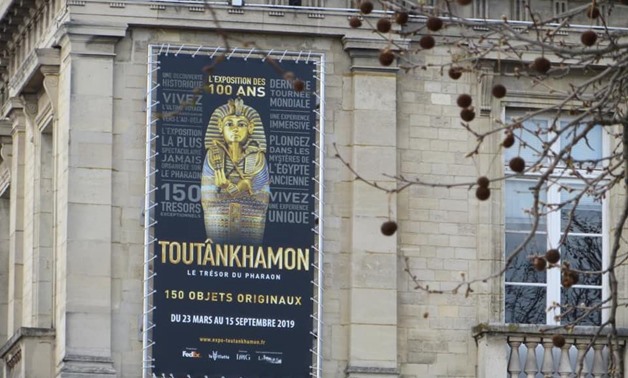
Poster of Tutankhamun exhibition in Paris - Facebook
CAIRO – 16 March 2019: Paris is preparing itself to welcome the exhibition of the golden pharaoh Tutankhamun to be inaugurated on the 21st of March, after more than 50 years of absence since 1967 when more than 1.2 million visitors were gathered to admire the treasures of King Tutankhamun.
Banners and posters showing the face of the boy king as well as objects from his treasured collection are wide spread over Paris streets. They are installed on buildings, shops, street lamps, metro and bus stations.
Meanwhile photos of the collection have caught the front pages and covers of all French newspapers and magazines.
The temporary exhibition “King Tut: Treasures of the Golden Pharaoh” will be transferred from the California Science Center to grand Lafayette Hall in Paris, France, from March 21, 2019, to Sept. 30, 2019.
This move aims to promote the cultural ties between Egypt and the world, while also boosting international tourism in Egypt.
Artifacts from King Tutankhamun’s tomb have been shown at an exhibit since March 24, 2018. The exhibit’s date has coincided with the 100th anniversary of the discovery of King Tutankhamun’s tomb.
The most famous ancient Egyptian king’s tomb was discovered in 1922; more than 3,000 years after his death.
The 150-artifact collection exhibited at the California Science Center is the biggest collection of artifacts from King Tutankhamun’s tomb to be shown outside of Egypt.
The artifacts were displayed for 10 months before being transferred to Europe to be shown there in January 2019.
The Golden King exhibition is scheduled to be held in France, Japan, US, Canada, Australia, and South Korea, where foreign exhibitions help increase the resources of the ministry in particular and the government in general.
Tutankhamun was born in the 18th Dynasty around 1341 B.C. and was the 12th pharaoh of that period. Tutankhamun did not accomplish much himself; he was placed on the throne when he was a child, and Egypt’s prosperous era was beginning to decline with the rise of Pharaoh Akhenaten and his new cult.
Sir Howard Carter, British archaeologist and Egyptologist, had made it his life’s quest to find the tomb of King Tutankhamun.
When Carter had begun to work in Egypt in 1891, most of the documented Pharaohs had their tombs discovered. One, however, proved to be elusive; King Tutankhamun, whose resting place had yet to be found and who Egyptologists knew very little about.
With the end of World War I, Carter made it his goal to be the first to uncover the tomb of Tutankhamun. Carter had worked in Egypt for 31 years since he was 17, using his skills as an artist to copy inscriptions from walls.
He would then become appointed inspector-general of monuments in Upper Egypt. In 1907, he started to work for George Herbert, the fifth earl of Carnarvon, who would aid him in his quest to uncover the lost tomb of Tutankhamun.
Carter was certainly dedicated, spending massive amounts of money and time in order to track down where the tomb might lie.
With Lord Carnarvon as his sponsor, they began working earnestly at excavating the Valley of Kings. Alas, even after five years of work, Carter wasn’t able to report back on anything substantial.
He refused to give up however, tirelessly working to fulfil his quest, and soon enough, Carter would be rewarded beyond his imagination.
The discovery of steps beneath the sand on November 1, 1922 was a breakthrough for Carter. At long last, his tireless search for Tutankhamun would finally bear fruit.
Carter announced the discovery on November 6, and it took three weeks until he could begin work on excavating into the tomb.
Workers exposed all of the steps and the sealed doorway into the tomb, which at one point had been broken in by tomb robbers but resealed again, leading to hope that the contents had not been plundered.
Carter finally entered on November 25, finding evidence of resealed holes but noting that it had likely been thousands of years since anyone had entered again.
When Carter made a hole inside the sealed door and peeked inside, he was left astounded. Gold flooded his senses, and animal statues, rich perfumes, piles of ebony, childhood toys and the Pharaoh himself adorned the room alongside countless other treasures.
It was a bounty of riches the likes of which had never been seen before; Carter couldn’t have anticipated this finding in his wildest dreams.

Comments
Leave a Comment